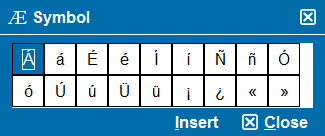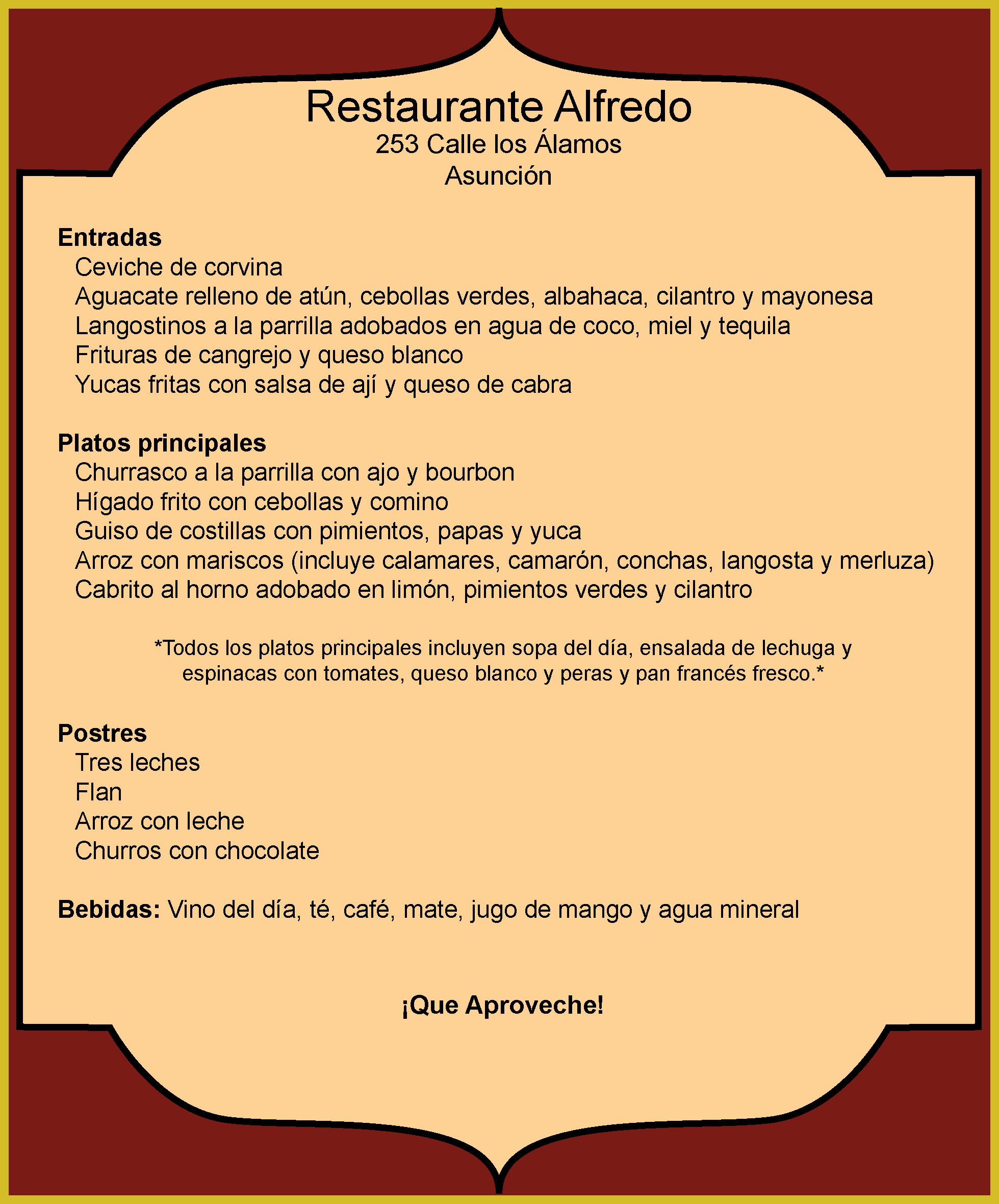Study Guide
Field 129: Spanish CST
Pedagogical Content Knowledge
Recommendation for individuals using a screenreader: please set your punctuation settings to "most."
Review the
character selector tutorial video
![]() and the
special character palette available for the Spanish CST:
and the
special character palette available for the Spanish CST:
Directions for Pedagogical Content Knowledge Assignment
For the Pedagogical Content Knowledge section of the test, you will write a response of approximately 400 to 600 words start bold in English end bold to an assignment.
Read the assignment carefully before you begin to write. Think about how you will organize your response. You should use your time to plan, write, review, and edit your response to the assignment. Your final response must be typed in the on-screen response box presented with the assignment.
Please note that special characters (such as letters with accents or other diacritical marks) cannot be entered using the keyboard, but are available for insertion in the on-screen response box. To access these characters, click on the
button that appears in the upper left corner of the screen. Using the mouse, double-click on the character you wish to include in your response, or click on the character and then select " start bold Insert end bold ." The character will be inserted where the cursor is positioned in the response box.
Your response will be evaluated according to the following criteria:
- start bold COMPLETENESS: end bold The degree to which the response addresses all parts of the assignment
- start bold ACCURACY: end bold The degree to which the response demonstrates the relevant knowledge and skills accurately and effectively
- start bold DEPTH OF SUPPORT: end bold The degree to which the response provides appropriate examples and details that demonstrate sound reasoning
Your response will be evaluated on the criteria above, not writing ability. However, your response must be communicated clearly enough to permit valid judgment of your knowledge and skills. Your response must be your original work, written in your own words, and not copied or paraphrased from some other work.
Be sure to write about the assigned topic. Remember to review what you have written to ensure that you address all aspects of the assignment and make any changes you think will improve your response.
Select the start bold Next end bold button to continue.
Sample Pedagogical Content Knowledge Assignment
Competency 0005
Pedagogical Content Knowledge
start bold Use the information below and the exhibit provided to complete the assignment that follows. end bold
You are planning instruction for a Spanish language class. Your instruction includes a specific learning goal aligned to the following New York State Learning Standard for Languages Other Than English:
Standard 1: Students will be able to use a language other than English for communication.
You will use the exhibit provided as part of your instruction. To view the exhibit, click the "Exhibit" button on the right above the response box.
Using your knowledge of Spanish and your pedagogical knowledge related to teaching modern languages, write a response in English of approximately 400 to 600 words in which you:
- state the grade level (middle school or high school) of your instruction;
- state the NYS Checkpoint level (A, B, or C) that aligns to your instruction;
- identify a specific learning goal that aligns with the given standard and the grade level and NYS Checkpoint you have identified, and that relates to the given exhibit;
- provide a rationale for the learning goal you have identified;
- describe a research- or evidence-based instructional strategy or activity you would use to promote student achievement of the specified learning goal and explain how you would use the given exhibit to support your instruction; and
- describe an effective formative or summative assessment tool, strategy, or activity you would use to measure student achievement of the specified learning goal.
start italics [The examinee will see the Exhibit
button on screen:
 ] end italics
] end italics
To view the exhibit, the examinee will click the Exhibit button. The pop-up window can then be resized and/or repositioned on the screen so that the examinee can access the information while completing their response.
Exhibit
Restuarant Menu in Spanish the top heading says Restaurante Alfredo then it has details on the restaurant 253 Calle los Álamos Asunción the next heading is Entradas with a list underneath Ceviche de corvina Aguacate relleno de atún, cebollas verdes, albahaca, cilantro y mayonesa Langostinos a la parrilla adobados en agua de coco, miel y tequila Frituras de cangrejo y queso blanco Yucas fritas con salsa de ají y queso de cabra the next section heading is Platos principales with a list underneath Churrasco a la parrilla con ajo y bourbon Hígado frito con cebollas y comino Guiso de costillas con pimientos, papas y yuca Arroz con mariscos (incluye calamares, camarón, conchas, langosta y merluza) Cabrito al horno adobado en limón, pimientos verdes y cilantro then there is a section indicating emphasis to the section above *Todos los platos principales incluyen sopa del día, ensalada de lechuga y espinacas con tomates, queso blanco y peras y pan francés fresco.* the next section heading is Postres with a list underneath Tres leches Flan Arroz con leche Churros con chocolate then the last section has a heading of Bebidas: with a list Vino del día, té, café, mate, jugo de mango y agua mineral and at the very bottom on the menu it says ¡Que Aproveche!
Sample Strong Response to Pedagogical Content Knowledge Assignment
This restaurant menu contains extensive food vocabulary and is an appropriate resource to use throughout all levels of instruction in Spanish. My instructional strategy is for a middle school Spanish class at Checkpoint A. My specific learning goal is for students to communicate in Spanish by expressing personal feelings and opinions about food items using the verb "gustar". Students engaged in this lesson will already be familiar with the basic phrases "¿Qué (no) te gusta? ¿(No) Te gusta + blank ? (No) Me gusta + blank ." The rationale for this instruction is to apply the "gustar" structure to communicate about familiar and unfamiliar new foods, expand the students' range of culturally relevant food vocabulary, and use contextual clues to expand the use and recognition of familiar and unfamiliar foods.
In order to help students derive meaning from the exhibit, I would draw on research on reading strategies, in particular the use of context, cognates, and identification of important words. As part of a thematic unit on meal taking, I will set up the following activities.
I will first provide a printed copy of the exhibit and a teacher prepared chart with categories dealing with types of foods and beverages. I will elicit familiar vocabulary orally and categorize it with the students. Because one of my goals is to help students become more confident in dealing with unfamiliar vocabulary, I will direct students to highlight unfamiliar words so that the student's copy of the exhibit shows how much they can comprehend in context.
Next I will conduct an assessment to check comprehension of the important vocabulary by displaying pictures of the food and seasoning items on flash cards and asking students to select among the highlighted words in the exhibit which food item is displayed on the cards. Then I will use the cards as props for "gustar" questions that reinforce vocabulary and provide practice with the verb "gustar" while drawing attention to the menu. I will ask these types of questions while holding up different flash cards: "¿Qué es? ¿Qué tipo de comida es--fruta, carne, verdura, bebida, postre? ¿A ti te gusta(n) el/la/los/las? ¿Y a ti [directed to another student]? ¿Te gusta(n) o no? ¿Qué te gusta comer en un restaurante? ¿Tienes un restaurante favorito? ¿Qué hay en el menú de tu restaurante favorito?" At this point, students are able to complete the chart.
I will display all of the cards in the room and show a series of questions using "gustar" on the Smart Board similar to the oral practice I used with the flash cards. Students will work in pairs using "gustar" to elicit conversation about the food items on the flash cards. I will circulate throughout the class listening to the conversations and eliciting additional conversation as needed. By doing this activity I will be able to hear individual students and to what degree each of them is able to use the vocabulary on the menu and the "gustar" structure in context. This will allow me to recognize whether the stated learning goal has been met or whether I need to adjust my instruction.
Performance Characteristics for Pedagogical Content Knowledge Assignment
The following characteristics guide the scoring of responses to the Pedagogical Content Knowledge assignment.
| COMPLETENESS | The degree to which the response addresses all parts of the assignment |
|---|---|
| ACCURACY | The degree to which the response demonstrates the relevant knowledge and skills accurately and effectively |
| DEPTH OF SUPPORT | The degree to which the response provides appropriate examples and details that demonstrate sound reasoning |
Score Scale for Pedagogical Content Knowledge Assignment
A score will be assigned to the response to the Pedagogical Content Knowledge assignment according to the following score scale.
| Score Point | Score Point Description |
|---|---|
| 4 | The "4" response reflects a thorough command of the relevant knowledge and skills. |
| 3 | The "3" response reflects a general command of the relevant knowledge and skills. |
| 2 | The "2" response reflects a partial command of the relevant knowledge and skills. |
| 1 | The "1" response reflects little or no command of the relevant knowledge and skills. |
| U | The response is unscorable because it is unrelated to the assigned topic or off-task, unreadable, written in a language other than English or contains an insufficient amount of original work to score. |
| B | No response. |


